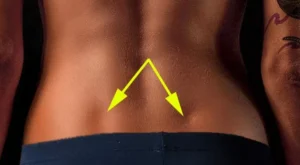Known as the “dimples of Venus,” the little indentations on the lower back have a special position in the realm of physical beauty. These dimples, which are formally called fossae lumbales laterales, are situated close to the top of the buttocks, directly above the junction where the spine and pelvis meet. The term “dimples of Venus” refers to the Roman goddess of love, beauty, and desire, Venus. This moniker reflects the historical perception of these indentations as physical representations of attraction.

The sacroiliac joint’s anatomy, not muscles as one might assume, is what creates the dimples. The sacrum, the triangle bone at the base of the spine, and the iliac spine of the pelvis are joined by this joint. Where the skin is attached to these underlying ligaments, a shallow depression is formed, which is where the dimples appear. They are completely genetically based, thus a person is either born with them or not, and no amount of deliberate exercise can cause them to manifest. Nonetheless, losing weight and doing specific body-sculpting activities that draw attention to muscle tone might draw attention to and intensify the dimples.

Though they are found in men less frequently, these dimples are more commonly seen in women, where they contribute to the hourglass figure ideal. Men may have what is known as “Apollo’s dimples,” named for the Roman deity of youth and physical attractiveness. These tiny depressions, on either sex, are admired for their symmetry and uniqueness and have long been linked to an idealized conception of physical beauty.
It’s interesting to note that the dimples appeal to people of all genders. These dimples add to the lower back’s natural curve, giving both men and women who have them the appearance of having a well-proportioned, sculpted figure. They are frequently the target of jealous looks or admiration since they are seen as epitome of elegance and sensuality in popular culture.

Venus’s dimples are sometimes compared to other desirable physical characteristics in society, like a prominent jawline, well-defined abs, or prominent cheekbones, yet they are nevertheless illusive. Since natural anatomy rather than muscle plays a role in their growth, exercise is not necessary to develop them. For individuals who already have them, however, lowering body fat through nutrition and exercise can help put them into greater perspective.
Venus’s dimples have been considered a sign of beauty for generations, appreciated for their subtle yet unique addition to the human form. Their connection to gods and goddesses attests to the enduring respect of the human body’s symmetry and beauty. These organic blemishes, which some people have without effort, serve as a reminder that there are many different kinds of physical attractiveness, most of which are unavoidable and best appreciated.
